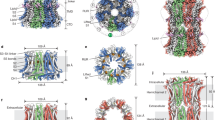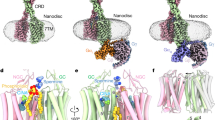Abstract
Distinguishing between allostery and competition among modulating ligands is challenging for large target molecules. Out of practical necessity, inferences are often drawn from in vitro assays on target fragments, but such inferences may belie actual mechanisms. One key example of such ambiguity concerns calcium-binding proteins (CaBPs) that tune signaling molecules regulated by calmodulin (CaM). As CaBPs resemble CaM, CaBPs are believed to competitively replace CaM on targets. Yet, brain CaM expression far surpasses that of CaBPs, raising questions as to whether CaBPs can exert appreciable biological actions. Here, we devise a live-cell, holomolecule approach that reveals an allosteric mechanism for calcium channels whose CaM-mediated inactivation is eliminated by CaBP4. Our strategy is to covalently link CaM and/or CaBP to holochannels, enabling live-cell fluorescence resonance energy transfer assays to resolve a cyclical allosteric binding scheme for CaM and CaBP4 to channels, thus explaining how trace CaBPs prevail. This approach may apply generally for discerning allostery in live cells.
This is a preview of subscription content, access via your institution
Access options
Subscribe to this journal
Receive 12 print issues and online access
$259.00 per year
only $21.58 per issue
Buy this article
- Purchase on Springer Link
- Instant access to full article PDF
Prices may be subject to local taxes which are calculated during checkout






Similar content being viewed by others
Accession codes
References
Wang, L., Martin, B., Brenneman, R., Luttrell, L.M. & Maudsley, S. Allosteric modulators of G protein–coupled receptors: future therapeutics for complex physiological disorders. J. Pharmacol. Exp. Ther. 331, 340–348 (2009).
Ritter, S.L. & Hall, R.A. Fine-tuning of GPCR activity by receptor-interacting proteins. Nat. Rev. Mol. Cell Biol. 10, 819–830 (2009).
Li, Y., Krupa, B., Kang, J.S., Bolshakov, V.Y. & Liu, G. Glycine site of NMDA receptor serves as a spatiotemporal detector of synaptic activity patterns. J. Neurophysiol. 102, 578–589 (2009).
Hynes, R.O. Integrins: bidirectional, allosteric signaling machines. Cell 110, 673–687 (2002).
Alberts, B. et al. Molecular Biology of the Cell 3rd edn., 195–222 (Garland, 1996).
Goodey, N.M. & Benkovic, S.J. Allosteric regulation and catalysis emerge via a common route. Nat. Chem. Biol. 4, 474–482 (2008).
Grunwald, M.E., Zhong, H., Lai, J. & Yau, K.W. Molecular determinants of the modulation of cyclic nucleotide-activated channels by calmodulin. Proc. Natl. Acad. Sci. USA 96, 13444–13449 (1999).
Dunlap, K. Calcium channels are models of self-control. J. Gen. Physiol. 129, 379–383 (2007).
Peterson, B.Z., DeMaria, C.D., Adelman, J.P. & Yue, D.T. Calmodulin is the Ca2+ sensor for Ca2+-dependent inactivation of L-type calcium channels. Neuron 22, 549–558 (1999).
Zühlke, R.D., Pitt, G.S., Deisseroth, K., Tsien, R.W. & Reuter, H. Calmodulin supports both inactivation and facilitation of L-type calcium channels. Nature 399, 159–162 (1999).
Alseikhan, B.A., DeMaria, C.D., Colecraft, H.M. & Yue, D.T. Engineered calmodulins reveal the unexpected eminence of Ca2+ channel inactivation in controlling heart excitation. Proc. Natl. Acad. Sci. USA 99, 17185–17190 (2002).
Haeseleer, F. et al. Five members of a novel Ca2+-binding protein (CABP) subfamily with similarity to calmodulin. J. Biol. Chem. 275, 1247–1260 (2000).
Haeseleer, F. et al. Essential role of Ca2+-binding protein 4, a Cav1.4 channel regulator, in photoreceptor synaptic function. Nat. Neurosci. 7, 1079–1087 (2004).
Yang, P.S. et al. Switching of Ca2+-dependent inactivation of CaV1.3 channels by calcium binding proteins of auditory hair cells. J. Neurosci. 26, 10677–10689 (2006).
Cui, G. et al. Ca2+-binding proteins tune Ca2+-feedback to Cav1.3 channels in mouse auditory hair cells. J. Physiol. (Lond.) 585, 791–803 (2007).
Lee, S., Briklin, O., Hiel, H. & Fuchs, P. Calcium-dependent inactivation of calcium channels in cochlear hair cells of the chicken. J. Physiol. (Lond.) 583, 909–922 (2007).
Lee, A. et al. Differential modulation of Cav2.1 channels by calmodulin and Ca2+-binding protein 1. Nat. Neurosci. 5, 210–217 (2002).
Yang, J. et al. Identification of a family of calcium sensors as protein ligands of inositol trisphosphate receptor Ca2+ release channels. Proc. Natl. Acad. Sci. USA 99, 7711–7716 (2002).
Kasri, N.N. et al. Regulation of InsP3 receptor activity by neuronal Ca2+-binding proteins. EMBO J. 23, 312–321 (2004).
Zhou, H. et al. Ca2+-binding protein-1 facilitates and forms a postsynaptic complex with Cav1.2 (L-type) Ca2+ channels. J. Neurosci. 24, 4698–4708 (2004).
Haeseleer, F. & Palczewski, K. Calmodulin and Ca2+-binding proteins (CaBPs): variations on a theme. Adv. Exp. Med. Biol. 514, 303–317 (2002).
Oz, S. et al. Competitive and non-competitive regulation of calcium-dependent inactivation in CaV1.2 L-type Ca2+ channels by calmodulin and Ca2+-binding protein 1. J. Biol. Chem. 288, 12680–12691 (2013).
Findeisen, F. & Minor, D.L. Jr. Structural basis for the differential effects of CaBP1 and calmodulin on CaV1.2 calcium-dependent inactivation. Structure 18, 1617–1631 (2010).
Ben Johny, M., Yang, P.S., Bazzazi, H.X. & Yue, D.T. Dynamic switching of calmodulin interactions underlies Ca2+ regulation of CaV1.3 channels. Nat. Commun. 4, 1717 (2013).
Liu, X., Yang, P.S., Yang, W. & Yue, D.T. Enzyme-inhibitor-like tuning of Ca2+ channel connectivity with calmodulin. Nature 463, 968–972 (2010).
Erickson, M.G., Liang, H., Mori, M.X. & Yue, D.T. FRET two-hybrid mapping reveals function and location of L-type Ca2+ channel CaM preassociation. Neuron 39, 97–107 (2003).
Findeisen, F., Rumpf, C. & Minor, D.L. Apo states of calmodulin and CaBP1 control CaV1 voltage-gated calcium channel function through direct competition for the IQ domain. J. Mol. Biol. 425, 3217–3234 (2013).
de Leon, M. et al. Essential Ca2+-binding motif for Ca2+-sensitive inactivation of L-type Ca2+ channels. Science 270, 1502–1506 (1995).
Kim, J., Ghosh, S., Nunziato, D.A. & Pitt, G.S. Identification of the components controlling inactivation of voltage-gated Ca2+ channels. Neuron 41, 745–754 (2004).
Dick, I.E. et al. A modular switch for spatial Ca2+ selectivity in the calmodulin regulation of CaV channels. Nature 451, 830–834 (2008).
Oz, S., Tsemakhovich, V., Christel, C.J., Lee, A. & Dascal, N. CaBP1 regulates voltage-dependent inactivation and activation of CaV1.2 (L-type) calcium channels. J. Biol. Chem. 286, 13945–13953 (2011).
Zhou, H., Yu, K., McCoy, K.L. & Lee, A. Molecular mechanism for divergent regulation of Cav1.2 Ca2+ channels by calmodulin and Ca2+-binding protein-1. J. Biol. Chem. 280, 29612–29619 (2005).
Lorenzen, A. & Schwabe, V. in Purinergic and Pyrimidinergic Signalling I (eds. Abbracchio, M.P. & Williams, M.) 19–34 (Springer-Verlag, 2001).
Logothetis, D.E., Lupyan, D. & Rosenhouse-Dantsker, A. Diverse Kir modulators act in close proximity to residues implicated in phosphoinositide binding. J. Physiol. (Lond.) 582, 953–965 (2007).
Lein, E.S. et al. Genome-wide atlas of gene expression in the adult mouse brain. Nature 445, 168–176 (2007).
Belgard, T.G. et al. A transcriptomic atlas of mouse neocortical layers. Neuron 71, 605–616 (2011).
Blackshaw, S. et al. Genomic analysis of mouse retinal development. PLoS Biol. 2, E247 (2004).
Colantuoni, C. et al. Temporal dynamics and genetic control of transcription in the human prefrontal cortex. Nature 478, 519–523 (2011).
Vogel, C. & Marcotte, E.M. Insights into the regulation of protein abundance from proteomic and transcriptomic analyses. Nat. Rev. Genet. 13, 227–232. 10.1038/nrg3185 (2012).
Chao, S.H., Suzuki, Y., Zysk, J.R. & Cheung, W.Y. Activation of calmodulin by various metal cations as a function of ionic radius. Mol. Pharmacol. 26, 75–82 (1984).
Erickson, M.G., Alseikhan, B.A., Peterson, B.Z. & Yue, D.T. Preassociation of calmodulin with voltage-gated Ca2+ channels revealed by FRET in single living cells. Neuron 31, 973–985 (2001).
Mori, M.X., Vander Kooi, C.W., Leahy, D.J. & Yue, D.T. Crystal structure of the CaV2 IQ domain in complex with Ca2+/calmodulin: high-resolution mechanistic implications for channel regulation by Ca2+. Structure 16, 607–620 (2008).
Mori, M.X., Erickson, M.G. & Yue, D.T. Functional stoichiometry and local enrichment of calmodulin interacting with Ca2+ channels. Science 304, 432–435 (2004).
Hill, T.L. Free Energy Transduction in Biology: The Steady-State Kinetic and Thermodynamic Formalism 64 (Academic Press, 1977).
Xu, W. & Lipscombe, D. Neuronal CaV1.3α1 L-type channels activate at relatively hyperpolarized membrane potentials and are incompletely inhibited by dihydropyridines. J. Neurosci. 21, 5944–5951 (2001).
Samsó, M. & Wagenknecht, T. Apocalmodulin and Ca2+-calmodulin bind to neighboring locations on the ryanodine receptor. J. Biol. Chem. 277, 1349–1353 (2002).
Bosanac, I. et al. Crystal structure of the ligand binding suppressor domain of type 1 inositol 1,4,5-trisphosphate receptor. Mol. Cell 17, 193–203 (2005).
Lin, C., Widjaja, J. & Joseph, S.K. The interaction of calmodulin with alternatively spliced isoforms of the type-I inositol trisphosphate receptor. J. Biol. Chem. 275, 2305–2311 (2000).
Yamada, M. et al. The calmodulin-binding domain in the mouse type 1 inositol 1,4,5-trisphosphate receptor. Biochem. J. 308, 83–88 (1995).
Gough, N.R. Biochemistry: quantifying interactions. Sci. Signal. 3, ec62 (2010).
Eaves, H.L. & Gao, Y. MOM: maximum oligonucleotide mapping. Bioinformatics 25, 969–970 (2009).
Acknowledgements
We thank W. Yang for dedicated technical support and other members of the Ca2+ signals lab for valuable comments. H. Bazzazi generously made available the β2a–CaMWT construct. Y. Gao contributed the data analysis showing CaM, CaBP4 and CaBP1 gene expression from human prefrontal cortex. This work is supported by grants from the US National Institutes of Health (NIH) Heart, Lung, and Blood Institute MERIT Award (to D.T.Y.), NIH National Institute on Deafness and Other Communication Disorders (P.S.Y. and P. Fuchs), NIH National Institute of General Medical Sciences (GM08752 to P.S.Y.) and the NIH National Institute of Mental Health (M.B.J.).
Author information
Authors and Affiliations
Contributions
P.S.Y. created mutant, chimeric and engineered channels. P.S.Y. and M.B.J. performed electrophysiology and FRET experiments and undertook extensive data analysis. M.B.J. performed molecular modeling. D.T.Y. supervised and helped conceive the project. All of the authors refined hypotheses, wrote the paper and created figures.
Corresponding author
Ethics declarations
Competing interests
The authors declare no competing financial interests.
Supplementary information
Supplementary Text and Figures
Supplementary Results, Supplementary Figures 1–12 and Supplementary Notes 1 and 2. (PDF 4031 kb)
Rights and permissions
About this article
Cite this article
Yang, P., Johny, M. & Yue, D. Allostery in Ca2+ channel modulation by calcium-binding proteins. Nat Chem Biol 10, 231–238 (2014). https://doi.org/10.1038/nchembio.1436
Received:
Accepted:
Published:
Issue Date:
DOI: https://doi.org/10.1038/nchembio.1436



